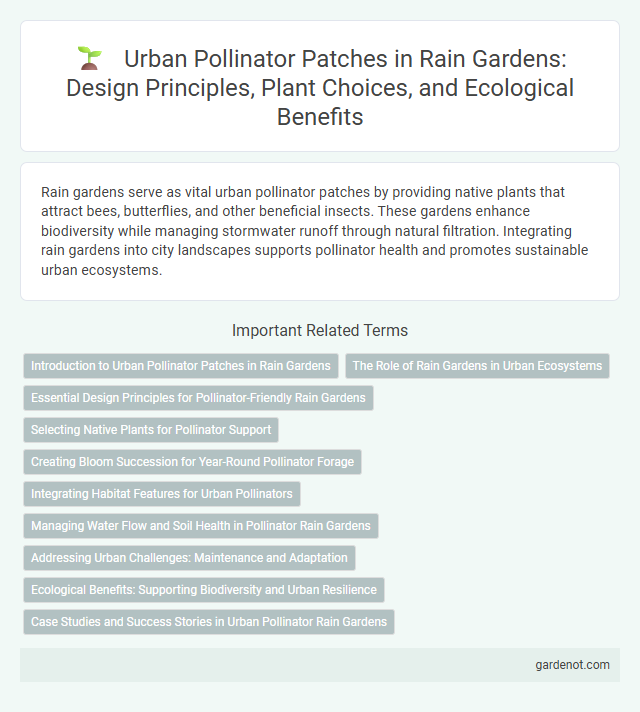Rain gardens serve as vital urban pollinator patches by providing native plants that attract bees, butterflies, and other beneficial insects. These gardens enhance biodiversity while managing stormwater runoff through natural filtration. Integrating rain gardens into city landscapes supports pollinator health and promotes sustainable urban ecosystems.
Introduction to Urban Pollinator Patches in Rain Gardens
Urban pollinator patches in rain gardens serve as vital habitats supporting diverse pollinator species like bees, butterflies, and hummingbirds within city landscapes. These patches enhance biodiversity by providing native flowering plants that supply essential nectar and pollen, improving urban ecosystem health. Integrating pollinator patches into rain gardens also aids stormwater management by promoting soil infiltration and reducing runoff, aligning ecological benefits with urban sustainability goals.
The Role of Rain Gardens in Urban Ecosystems
Rain gardens play a crucial role in urban ecosystems by providing essential habitats for pollinators such as bees, butterflies, and hummingbirds. These gardens enhance biodiversity by supporting native plant species, which supply nectar and pollen, critical for sustaining urban pollinator populations. Incorporating rain gardens into city landscapes improves ecosystem services, including water filtration and stormwater management, while fostering pollinator resilience amid urbanization.
Essential Design Principles for Pollinator-Friendly Rain Gardens
Urban pollinator patches thrive when rain gardens integrate native flowering plants that bloom sequentially throughout the growing season, providing continuous nectar and pollen sources. Soil permeability and proper drainage ensure water retention without saturation, fostering healthy root systems crucial for diverse pollinator habitats. Incorporating layered vegetation structure, including ground cover, herbaceous flowers, and shrubs, enhances shelter and nesting opportunities for bees, butterflies, and other beneficial insects.
Selecting Native Plants for Pollinator Support
Selecting native plants for an urban pollinator patch enhances biodiversity by providing essential nectar and pollen sources tailored to local pollinators like bees, butterflies, and hummingbirds. Native species such as purple coneflower, black-eyed Susan, and milkweed support pollinator lifecycle needs and improve habitat resilience against pests and diseases. Incorporating a variety of bloom times and plant structures maximizes seasonal foraging opportunities and ensures continuous pollinator activity throughout the growing season.
Creating Bloom Succession for Year-Round Pollinator Forage
Designing an urban pollinator patch with a strategic bloom succession ensures continuous availability of nectar and pollen throughout the year, supporting diverse pollinator species such as bees, butterflies, and hummingbirds. Incorporating a mix of native perennials, biennials, and annuals with staggered flowering periods maximizes habitat connectivity and enhances pollinator biodiversity. This sustainable approach promotes urban ecosystem health by maintaining forage resources across seasons, reducing habitat fragmentation caused by urban development.
Integrating Habitat Features for Urban Pollinators
Integrating diverse native flowering plants and nesting substrates within an urban pollinator patch creates essential habitat features that support pollinator diversity and abundance. Incorporating rain gardens with well-drained soils and intermittent moisture zones enhances resource availability for bees, butterflies, and other beneficial insects. Structural complexity through layered vegetation and sheltered microhabitats promotes foraging efficiency and refuge from urban stressors.
Managing Water Flow and Soil Health in Pollinator Rain Gardens
Urban pollinator patches within rain gardens play a crucial role in managing water flow by capturing and filtering stormwater runoff, reducing urban flooding and improving water quality. These gardens utilize native plants with deep root systems that enhance soil permeability, promoting groundwater recharge and preventing soil erosion. Maintaining soil health through organic amendments and avoiding compaction supports diverse microbial activity, creating an optimal environment for pollinators and resilient plant growth.
Addressing Urban Challenges: Maintenance and Adaptation
Urban pollinator patches integrated into rain gardens enhance biodiversity while addressing maintenance challenges through adaptive design strategies. Incorporating native, drought-resistant plant species reduces irrigation needs and supports pollinator resilience amid urban heat islands. Regular monitoring paired with community engagement ensures effective adaptation to environmental stressors and urban development pressures.
Ecological Benefits: Supporting Biodiversity and Urban Resilience
Urban pollinator patches within rain gardens create vital habitats that support diverse pollinator species, enhancing local biodiversity and promoting ecosystem stability. These green spaces aid in urban resilience by improving soil health, mitigating stormwater runoff, and reducing heat island effects. Incorporating native flowering plants attracts bees, butterflies, and other pollinators, sustaining ecological networks critical to urban environmental functioning.
Case Studies and Success Stories in Urban Pollinator Rain Gardens
Urban pollinator rain gardens have demonstrated significant ecological benefits, as evidenced by case studies in cities like Portland, Oregon, where native plantings increased pollinator diversity by 40% within two years. Success stories from Chicago's Millennium Park showcase how integrating rain gardens with pollinator habitats reduced stormwater runoff by 25%, while supporting over 30 species of bees and butterflies. These projects highlight the dual functionality of urban pollinator patches in enhancing biodiversity and improving urban water management.
Urban pollinator patch Infographic

 gardenot.com
gardenot.com